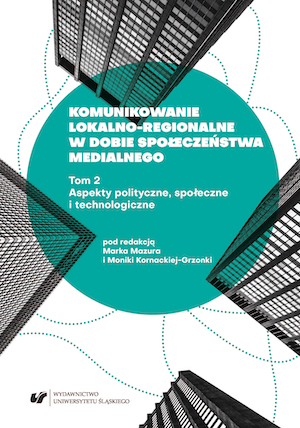

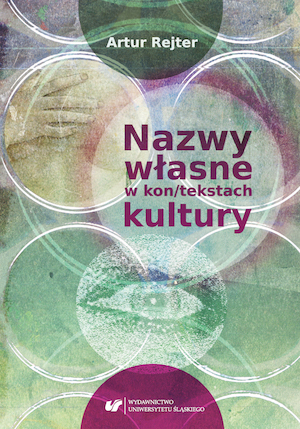
In this work, the author presents a firm conviction that proper names are specific cultural signs in terms of both understanding the culture’s historically varying dynamics and character, as well as diverse contexts in which proper names occur at a given stage of sociocultural development. Such an approach gives rise to certain revaluations in the analytic methods employed and – in a broader sense – the very essence of proper names. More frequently and definitely, contemporary onomastics seems to depart from traditional – and often orthodox – approaches, not only in terms of methodology but also objectives that the researchers set.The monograph provides various takes on the opportunities that onomastics along with its diverse instruments gives us. It is, however, worth highlighting that onomastics is understood as a field of linguistics that has a long established position and yet is subject to ceaseless methodological revaluations. We ought to expect that opening the onomastic reflections to other methods and pointing to their inter- and transdisciplinary implications may provide us with interesting effects and become an inspiration for further research.The reflections gathered in this book have been assigned to issues that constitute five themes; these themes reflect the author’s interests concerning the proper names related issues.The first group encompasses the texts touching upon the general, theoretical, and synthesising issues; to specify, it encompasses the author’s proposals of approaching onomastic issues with regard to the achievements of contemporary linguistics. These approaches attempt to propose research paths widening the scope of current perspectives. The next part gathers the onomastic re-interpretations of literary works from previous epochs (mainly baroque, but also positivism and the 20th century). The third part is comprised of the texts that place onomastics in the context of gender studies, which seems to be a rare in Polish linguistics. The question of onomastic analyses of pop-cultural texts is yet another rarity. The fourth part is therefore devoted to this issue. The monograph ends with two texts functioning as a reconnaissance, concerned with chosen thematic problems in ideonymy and zoonymy (part five). They should be treated as sui generis elaboration of the main issues tackled in the book.The author has always endeavoured to put the observed onyms in a greater perspective; they are thus socioculturally contextualised, regardless of whether the observation includes theoretical issues or the empirical dimension of the onomastic analyses in specific texts and communicational spaces. The presented research proposals mainly concentrate upon possibilities of onomastic research as complementary to other domains of contemporary linguistics. What is valorised here are mainly various spaces of text linguistics, such as stylistics, linguistic genology, or discourse theory, but the author also turns to a field dear to him – historical linguistics. Therefore, a proper name here is always a sign that focuses – like a lens – tendencies and tropes of wider fields, that is, sociocultural spaces.
More...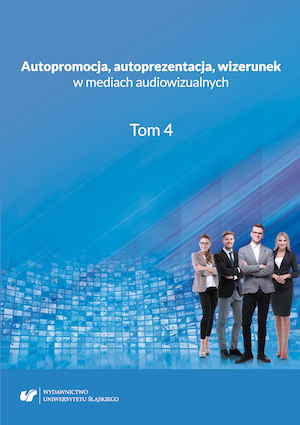
Keywords: Self-promotion; self-presentation; image in the media
Self-promotion, self-presentation, public image in audiovisual media is a collection of articles that, in this installment, search for strategies of creating public image in audiovisual media. The tactics referred to are therefore not merely a prompt for engaging into reflection on manifold individuals and social groups that use public sphere to promote their self-image, but also a perfect starting point to analyze the part of media landscape where, vie visual and verbal means the advertising of certain attitudes is done. (A fragment for the Introduction)
More...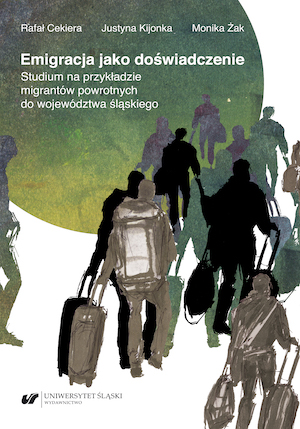
Keywords: migration; demography; typology of migrants; sociology of migration; Silesian Voivodeship
The post-accession migration amongst the Poles has constituted one of the most significant demographic processes in the country. Unfortunately, there are still too few works in the Polish Social Sciences on post-accession re-emigrants. The study considers the problem of return migration from the European Union countries to Poland and its socio-economic determinants, in the context of sociology of migration, sociology of work, demography and ethnicity, as well as the life-course perspective. The aim of the book is also to present a new typology of return migration.
More...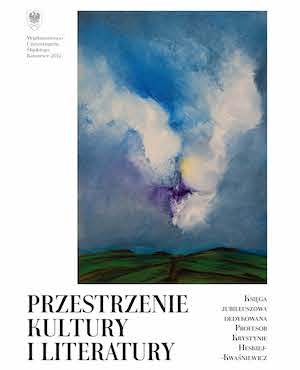
Keywords: Krystyna Heska-Kwaśniewicz
Prezentowana obszerna publikacja została przygotowana z okazji jubileuszu pięćdziesięciolecia pracy Pani Profesor Krystyny Heskiej-Kwaśniewicz – kierownika Zakładu Czytelnictwa Instytutu Bibliotekoznawstwa i Informacji Naukowej Uniwersytetu Śląskiego. Czytelnik ma możność zaznajomienia się z wydarzeniami i okolicznościami, jakie kształtowały osobowość Jubilatki, a także poznać przebieg Jej drogi naukowej i dydaktycznej, pasje. Może także zaznajomić się z Jej publikacjami. Autorzy opracowań składających się na tom, to przyjaciele, współpracownicy i uczniowie Pani Profesor. Teksty zostały pogrupowane tematycznie w pięć części ilustrujących pasje i zainteresowania Jubilatki: pierwsza sytuuje odbiorcę w kręgu literatury i świata wartości; druga ukazuje góry w kontekście literackim i kulturowym; trzecia dotyczy kultury literackiej na Śląsku; czwarta odnosi się do książki i literatury dla młodego czytelnika; piąta to po prostu varia.
More...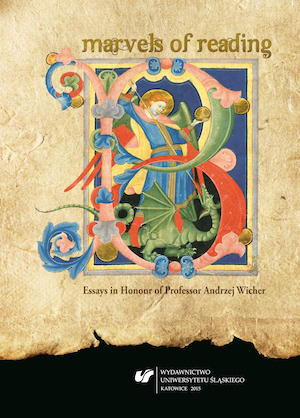
Keywords: English literature (Old and Middle English); the Middle Ages; the Renaissance; medieval studies; philosophy; melancholy; medievalism; translation; fairy tale; Geoffrey Chaucer; Sir Gawain and the Green Knight; John Milton; Gerard Manley Hopkins
"Marvels of Reading. Essays in Honour of Profesor Andrzej Wicher" jest tomem esejów napisanych w większości w języku angielskim i honorującym sześćdziesięciolecie urodzin profesora Andrzeja Wichra, jednego z czołowych mediewistów i szekspirologów polskich. Tom składa się z jedenastu tekstów autorstwa uznanych polskich badaczy literatury, kultury i filozofii krajów anglojęzycznych, przyjaciół i dawnych uczniów Profesora, a tematyka tekstów obraca się wokół zainteresowań badawczych jubilata: studiów nad literaturą starogermańską, staroangielską, średnioangielską, "Rajem utraconym" J. Miltona, poezją G. M. Hopkinsa, filozofią melancholii, strukturą baśni, a także tłumaczeniem średnioangielskiego romansu rycerskiego. Tom zawiera w sobie następujące artykuły: “Margery Kempe’s Roman (Purgatorial) Holiday, or on Penance and Pleasure in Medieval Journeys” (Liliana Sikorska); “Magic and Religion in the Prose Merlin” (Bartłomiej Błaszkiewicz); “All That is Wrought is not Gold: Locating Wealth in Old English Gnomic Texts” (Rafał Borysławski); “The Character of Iêsu Krist in the Old Saxon Gospel Harmony The Hêliand as a Dramatic Cultural Synthesis Combining Elements of Deep Christian Piety and the Germanic Code of Heroic Honour” (Łukasz Neubauer); “’Margaret, are you grieving over Goldengrove unleaving?’: ‘Spring and Fall’ in the Poetic Thoughts of Gerard Manley Hopkins (and Charles Taylor’s Philosophy)” (Ewa Borkowska); “Ethnically Different Mothers-in-law in Chaucer’s Man of Law’s Tale and Its 2003 BBC Adaptation” (Anna Czarnowus); “Jacques and the Politics of Melancholia” (Tadeusz Sławek); “Death and the Hero – Paradise Lost and the Problem of Theomachia” (Maria Błaszkiewicz); “A Fairy Tale in Focus: Ecstatic Focalisations in A Christmas Carol” (Jacek Mydla); „Czytanie cudów w Panu Gawenie i Zielonym Rycerzu i Opowieści Franklina” (Barbara Kowalik); “More Motivated Malignity? The Ominous Agenda of the Green Knight in Andrzej Wicher’s Translation of Sir Gawain and the Green Knight” (Piotr Spyra). Praca jest adresowana do filologów angielskich, badaczy literackiej kultury krajów anglosaskich, a także studentów filologii angielskiej.
More...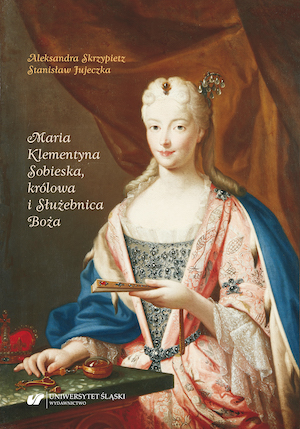
Keywords: Stuart; Sobieski; court; queen; marriage
Maria Clementina Sobieska (1701–1735) was the granddaughter of King Jan III. In 1718 she was assigned to James III Stuart. Stopped in Innsbruck, she ran away and married her chosen one. She bore him two sons, Charles Edward and Henry Benedict. The spouses settled in Rome in the Palazzo del Re, under the care and at the expense of the Pope. In 1725 Maria Clementina proposed against taking her custody of her sons and moved to a convent. Using international support, she forced James Stuart to make concessions and returned home. After her premature death, the family undertook steps that were to lead to her beatification. A preliminary trial was initiated in which Mary Clementine was called the God’s Servant.
More...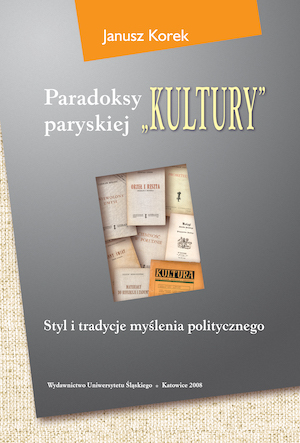
Keywords: Kultura; Political Thinking
The aim of the book is to analyze the political conceptions of the monthly“Kultura” in the period since its creation antil 1980. The magazine, whichstarted coming out in 1947 in Italy, was created by expatriate Poles, who afterthe Yalta Agreements chose to stay in the West. The editorial board soonmoved to France where on the outskirts of Paris in the small town of Maisons-Laffitte the monthly journal has been edited ever since. Thanks to the originalprofile of the magazine and its political philosophy it has managed to grouparound itself numerous outstanding Polish writers and commentators, boththose active in the emigré communities and those living in Poland. AlsoWestern authors as well as writers and commentators from other countries inCentral and Eastern Europe published their texts on the magazine’s pages.In spite of “Kultura’s” illustrious successes and unique accomplishments,earlier research on its history has hot moved beyond its initial stage. Inpublications devoted to the phenomenon of “Kultura” we may encountercontradictory ideological qualifications and opinions on the magazine’spolitical profile. This is a consequence of the fact that there is a painful lackof source materials and books analyzing the accomplishments of “Kultura”from a longterm perspective. This book aims to fill out this gap by analyzinga period of over thirty years in the history of the periodical. An attempt ismade to divide this history into periods on the basis of ideological and politicalcriteria. A further aim is to define the style of political thinking dominant inthe materials published in the periodical and to characterize it against thebackground of earlier political debates in pre-war Poland. The adopteddiachronic perspective and the wide spectrum of analyzed phenomena willprovide the basis for an assessment of which conceptions and ideologicalelements and values were constantly present in the political platform of theeditors and which made only a temporary appearance in connection with thepolitical sympathies of the periodical or the changing circumstances on theworld scene. It should be added that this is the first book on the subject totruly cover the comprehensive research material and to analyze the politicaltrends in “Kultura” from a long-term perspective.The main thesis of the book may be formulated(excerpt from the summary)
More...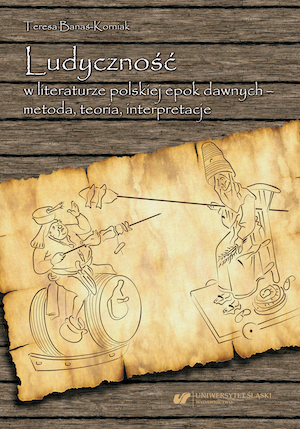
Keywords: ludicity; Polish literature and culture of the Renaissance and Baroque
The aim of the monographic study is to analyse and interpret Old Polish literary texts containing folkloric themes and motifs, using various research methods. In the introductory part of the book the author presents reflections which have appeared in the last twenty years in Poland and concerned the ways of researching early literature; she also expresses her own thoughts and proposals for reading sixteenth- and seventeenth-century texts on ludic themes. The author implements her suggestions in the interpretative chapter III, which includes, among others, the analysis of literary motif and poetic language, cultural and genological analysis, as well as stylistic and rhetorical analysis. In this chapter, the functions of the ludic text in social communication are also considered. The final conclusions of the work show various functions of ludic motifs, which appeared in literary texts of various themes and purposes (not necessarily related to recreation and fun).
More...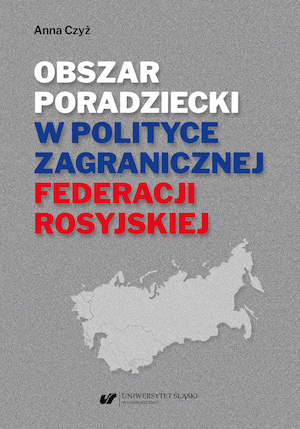
Keywords: Post-Soviet area; foreign policy; Russian Federation; Vladimir Putin
The publication refers to the place, importance and role of the post-Soviet area in the foreign policy of the Russian Federation after the collapse of the Soviet Union in 1991. This is an important and current topic, especially in the context of the ongoing war in Ukraine. The Russian Federation uses all possible instruments of influence to maintain control over the post-Soviet area, treated as the exclusive sphere of Russian influence and the priority direction of Russian foreign policy. The main goals of Russian foreign policy towards the so-called near-border include the political, economic and military integration of this area under the leadership of Russia.
More...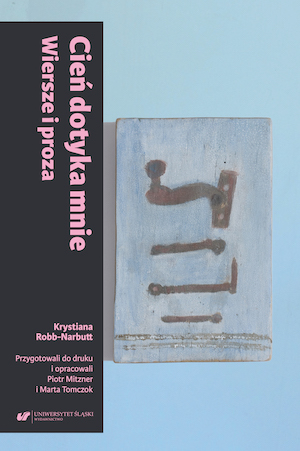
Keywords: Postholocaust Art; Second Generation Art; March 1968; objects; poems
Krystiana Robb-Narbutt is one of the most inspiring and at the same time least known Polish-Jewish artists and poets of the 20th and 21st centuries. She created prints, installations and objects, as well as miniature prose and poems. She exhibited them at Kordegarda and Zachęta, among other venues. In March 1968, she was sentenced to prison for participating in protests and distributing leaflets. The subjects of her work were biography and imagination. The book contains all of Robb-Narbutt’s poems and prose deciphered from manuscripts, as well as their critical consideration. They are supplemented by the voices of literary and art critics as well as friends of the artist.
More...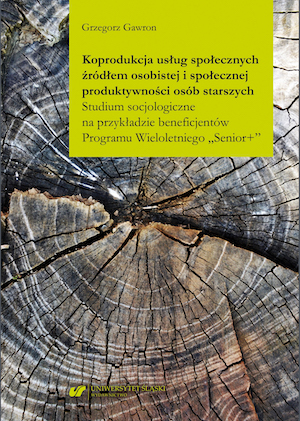
Keywords: Social services; human and social capital of older people; co-production of public services; co-production of older people; personal and social productivity of older people
The presented volume is the author’s proposal of a sociological description of the phenomenon of co-production of social services as a source of personal and social productivity of older people. The main conceptual axis of the study, which defines its cognitive goal, is an attempt to link the idea of co-production of social services with the productivity of older people, indicating the potential relations occurring between these phenomena. According to the author’s knowledge, both in Poland and abroad, no analyses in this area have been conducted so far, not only within sociology, but also within other sciences. Therefore, the theoretical aim of the study was to describe and rank the concepts constituting the backbone and filling in the presented theoretical perspective, such as co-production, personal and social productivity of the older persons, social services, human capital and social capital. The conceptual analysis carried out resulted in the development of the author’s operational framework for the services organised and provided under the “Senior+” Multiannual Programme, showing how co-production of older people, based on the use of their human and social capital, generates their personal and social productivity. Therefore, it can be considered that the publication is a direct response to the persistent deficit of comprehensive studies in this area in the Polish scientific space.
More...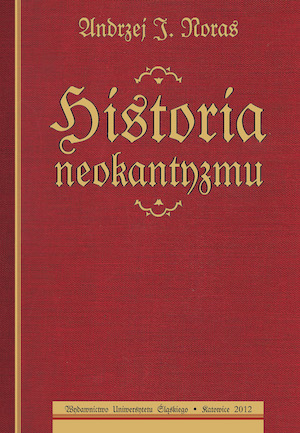
Keywords: neo-Kantianism
Neo-Kantianism, being one of the most important philosophical trends in thesecond half of the 19th century and the first twenty years of the 20th century, isan almost unknown phenomena. The World War II and, as a result of it, a dominationof an analytic philosophy in the European continent led to the situation inwhich as late as in the 1980s systematic studies on neo-Kantianism graduallystarted to be conducted. As a result of this research, a fuller picture of this extremelyimportant philosophical trend is created. Out of the necessity to show therichness of thought and its complexity within neo-Kantianism, the book consistingof two parts was written. The first part describes the origins of neo-Kantianism,while the second its development.The first part presents the most important elements that influenced the historicaldevelopment of neo-Kantianism. Thus, the analysis starts from terminologicaldesignation, necessary to present the characteristics of neo-Kantianism. Onlyestablishing a definition of neo-Kantianism and its time frames allows for historicalanalyses. Initial considerations, excluding terminological establishments, startfrom an assumption that a philosophy of neo-Kantianism does not come fromnothing, but is grounded in philosophers’ considerations referring to the conceptionof Immanuel Kant; and not only after Hegel’s death, but earlier, somewhatparallel to him. It seems that the most important philosophers have to be mentionedwho, during Hegel’s life, in a way against fashion, refer to Kant. The strongestopponents to Hegel are Arthur Schopenhauer, Jacob Friedrich Fries, Johann FriedrichHerbart, Friedrich Eduard Beneke and Bernard Bolzano. It needs to be statedthat it was not Schopenhauer, as it is commonly believed, but Fries whoplayed an important role in polemics with Hegel. However, the first to remindKant’s thought was Beneke.Further on, the subject of the study is the analysis of the role of philosophy inmid 19th century, a special emphasis being put on a few thinkers. The first ofthem is Friedrich Adolf Trendelenburg, the second Rudolph Hermann Lotze andthe third Johann Eduard Erdmann. As an important element of critique of Hegelspeculative teism as well as Christian Hermann Weiss’ and Immanuel HermannFichte’s philosophies ar mentioned. The next step is to show the disputes in understandingphilosophy that took place in the mid 19th century as an importantsource of neo-Kantianism. Particularly important are the disputes on materialismand debate between Trendelenburg and Kuno Fischer. Finally, the reference ismade to another two thinkers who, apart from the participants of the debate,mention Kant directly. They are Jürgen Bona Meyer and Ernst Freiherr vonFeuchtersleben. Here the name of Beneke apears once more, because of hispublication from 1832 entitled Kant und die philosophische Aufgabe unsererZeit, on the basis of which he can be called a precursor of neo-Kantianism.Besides, it seems that also Rudolf Haym, an author of Hegel und seine Zeitpublished 50 years after Hegel’s Phenomenology of Spirit, played an importantrole in neo-Kantianism development.The first part of the book concludes with the attempts to establish the date ofneo-Kantianism beginnings. It turns out that also this very issue cannot be unanimouslyresolved as the commentators give five different dates and connect themwith various events. The best-known event the beginning of neo-Kantianism isidentified with is 1865, a year in which Otto Liebmann published his famous andrenowned book entitled Kant und die Epigonen. But three years earlier, EduardZeller presented in Heidelberg, and, consequently, published his famous lectureÜber Bedeutung und Aufgabe der Erkentnistheorie. Additionally, the neo-Kantismresearchers point to three more dates, that is, 1855, (a speech by Hermann vonHelmholtz in Königsberg), 1860 (Kunon Fischer’s publication of books devoted toKant, and 1866, Friedrich Albert Lange’s publication of a famous Geschichte desMaterialismus und Kritik seiner Bedeutung in der Gegenwart).The second part of the book is structured analogously to the first and completedivision of neo-Kantianism. The very division was made for the first time in1916 in the eleventh edition, and, subsequently, a slightly modified version waspresented in 1923 in the twelfth edition of a famous Grundriss der Geschichte derPhilosophie by Friedrich Überweg (1826—1871). In 1916, and next in 1923 thefourth part of Überweg’s coursebook was published, the editor of which wasTraugott Konstantin Österreich (1880—1949). From today’s perspective, it isa classic division, distinguishing seven trends within the scope of neo-Kantianism.They are:— physiological trend (Hermann von Helmholtz, Friedrich Albert Lange),— metaphysical trend (Otto Liebmann, Johaness Volkelt),— relativism criticism (Georg Simmel),— psychological trend (Fries’ new school, Leonard Nelson),— realistic trend (Alois Riehl),— Baden school (Wilhelm Windelband, Heinrich Rickert, Hugo Münsterberg),— Marburg school (Hermann Cohen, Paul Natorp, Ernst Cassirer).The very division, deriving from the 1923 one, though in its original version, inwhich Österreich presented basically six trends, stems from the 1916 one, wasmodified and supplemented with philosophers who appeared vital from the perspectiveof a later history of philosophy. The physiological trend was supplementedwith the person of Hans Vaihinger while the metaphysical one withFriedrich Paulsen, Erich Adickes, Traugott Konstantin Österreich, and Max Wundt.Within the realistic trend, apart from Riehl, Oswald Külpe and Richard Hönigswaldwere included. The Marburg school required a discussion of others, apart fromCassirer and Cohen’s learners, especially such thinkers as Nicolai Hartmann,Albert Görland, Arthur Buchenau, Heinz Heimsoeth and Arthur Liebert. The presentationof a full picture of the Baden school was connected with an introductionof such philosophers as Emil Lask, Richard Kroner and Jonas Cohn. When it comesto relativism criticism, except for Georg Simmel, also Gustav Radbruch wastaken into account, whereas a psychological trend referring to Fries was supplementedwith two persons, namely Jürgen Bona Meyer and Hans Cornelius.A modified division of neo-Kantian trends was the basis of presentation andanalysis of the most important philosophers belonging to the current of neo-Kantianphilosophy.
More...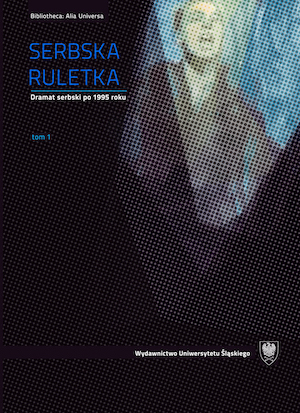
Keywords: Serbian drama
Serbska ruletka to wybór współczesnych dramatów serbskich. Znalazło się w nim 9 tekstów 9 autorów w następującej kolejności: w tomie pierwszym: Svetislav Basara Dolce vita; Miroljub Nedović Kraina ciemności; Mirjana Ojdanić Ślad ludzkich zębów; Nebojša Romčević Karolina Neuber; w tomie drugim: Goran Marković Willa Sachino; Milena Marković Statek dla lalek; Milena Minja Bogavac Czerwona. Seks i konsekwencje; Marija Karaklajić Twarz ze szkła; Maja Pelević Może jesteśmy Myszką Miki.Wszystkie utwory powstały po 1995 roku i żaden z nich nie był wcześniej ani w Polsce wydany, ani na język polski przetłumaczony. W wyborze uwzględniono zarówno teksty autorów średniego pokolenia, tych o ugruntowanej już pozycji, jak i młodych twórców, czasem zaledwie przed kilkoma laty debiutujących, ale już zauważonych i docenianych, teksty zróżnicowane tematycznie i gatunkowo. Ich autorzy nie są bynajmniej dla polskiego odbiorcy zupełnie anonimowi, trudno bowiem nie rozpoznać chociażby w osobach Gorana Markovicia, Svetislava Basary czy Mileny Marković artystów o międzynarodowej sławie. Wybrane dramaty to sztuki znane w Serbii, ale często też już poza jej granicami, nagradzane, zarówno za tekst, jak i za jego realizację sceniczną, na licznych festiwalach i konkursach teatralnych.
More...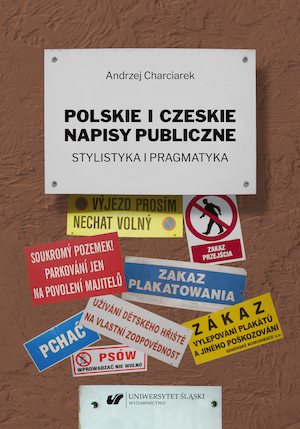
Keywords: inscriptions on public signs; pragmatics; stylistics; Polish language; Czech language
The subject of the monograph are inscriptions on Polish and Czech public signs perceived as a communicative and textual phenomenon connected with the place of their functioning, their sender-receiver relations and the functions they perform. The author focuses on the issues of the status of public signage and its stylistic and communicative determinants. He draws attention to the affinity of public signs with both administrative and colloquial texts, due to the different degree of stylistic awareness of their authors. The publication is mainly addressed to linguists interested in communicative and textological issues in contemporary Polish and Czech.
More...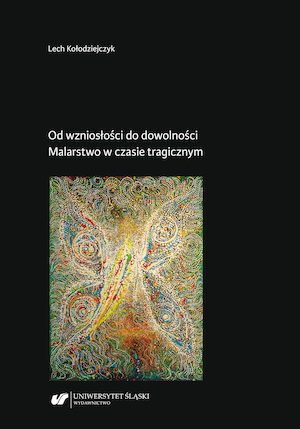
Keywords: alternative reality; creative dignity; spiritual space; source of evil; impulse of actuality; dehumanised world; chaotic reality; ordered reality; cultural codes; freedom in art; author’s state of consciousness; mental products; signs of the times
Written at the turn of 2021/2022, the monograph From Sublimity to Arbitrariness. Painting in the Tragic Time summarises numerous reflections and comments contained in two previous books: Pamięć czasu – malarstwo w czasie bankructwa duchowego [Memory of Time – Painting in a Time of Spiritual Bankruptcy] and Malarstwo jako egzystencja – tożsamość osobista a postawa twórcza [Painting as Existence – Personal Identity versus Creative Attitude]. The new publication, written in the context of the ongoing COVID-19 pandemic and, above all, the barbaric war in Ukraine, addresses the fundamental challenge of the present time concerning the foundations of the collapse of man's spiritual condition at the turn of the 20th and 21st centuries. The striking disappearance of moral and ethical content at the present time results in an exceptionally repulsive manifestation of numerous attitudes, where the pursuit of material goods effectively eliminates from our lives everything that is connected with a deep reflection on the meaning of human existence, its universal values, rigours, principles without which our life irretrievably loses its human dimension, turning into a hostile space of numerous threats, fears, frustrations, traumatic experiences and emotions. All this results in a growing avalanche of depressing arbitrariness and the striving for so-called freedom from everything, which only deepens the feeling of the current chaos and entropy in interpersonal relations, where the possibility of communicating with another human being becomes a fundamental problem.
More...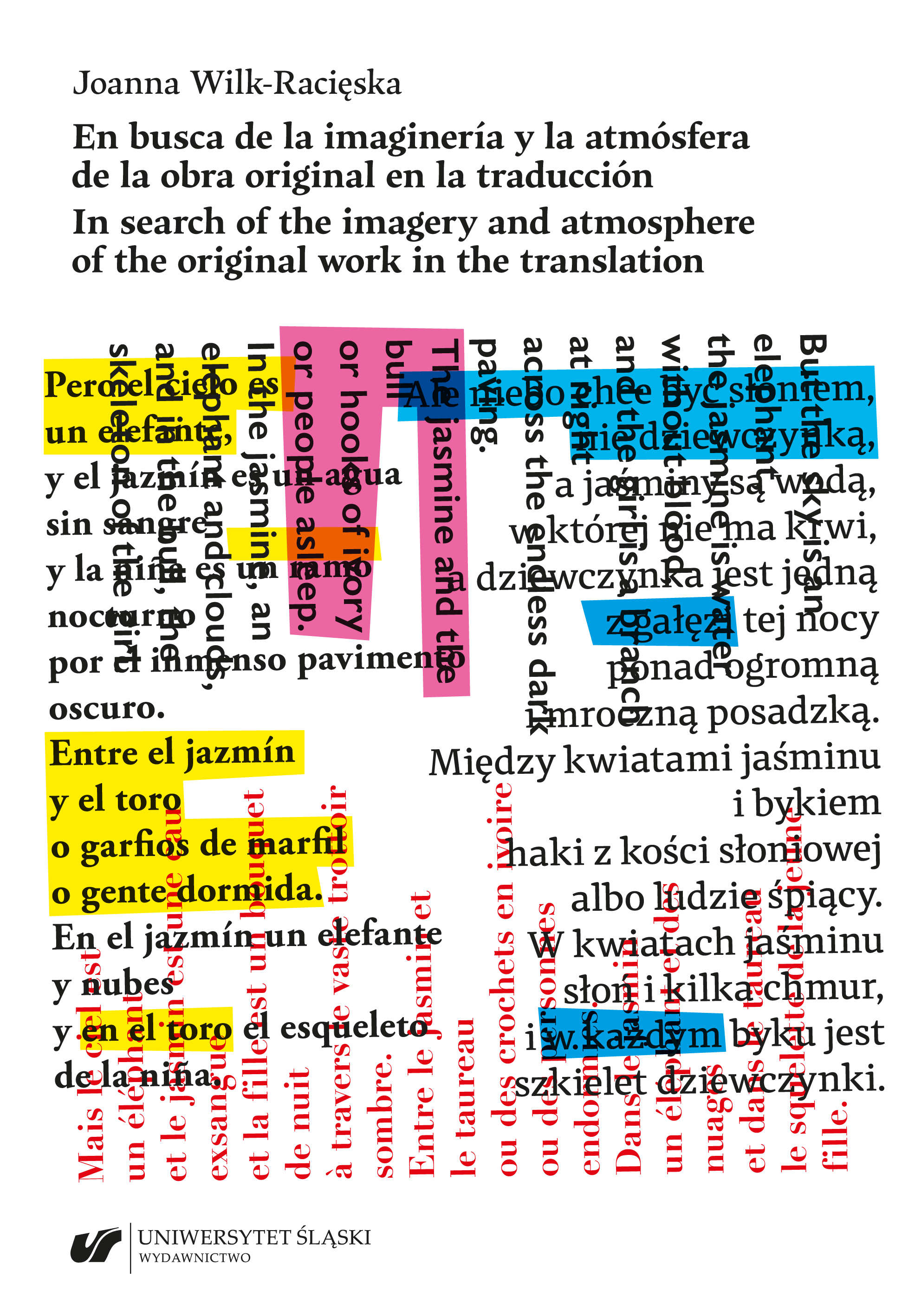
Keywords: applied linguistics; cognitive linguistics; traductology; poetry; imagery
The author offers an analysis of such a seemingly elusive thing as the description of the atmosphere of the source text in the target text. This task has led, relatively recently, to the formulation of perfunctory and subjective remarks that had nothing, or very little, to do with scientific inquiry, since there existed no specialized linguistic means to create and reproduce the author’s imagery that creates literary atmosphere. However, this publication has managed to avoid this danger thanks to the proposals of cognitive scientists. The starting point is the belief that writers — having only linguistic signs at their disposal — create images that remain fixed before the readers’ eyes. Part I describes the cognitive poetics tools for analyzing a literary work and its translation. Part II, on the other hand, focuses on the application of these “tools” to translations of experienced translators [into English, French, Polish and Russian] and a critical commentary on the result of their work.
More...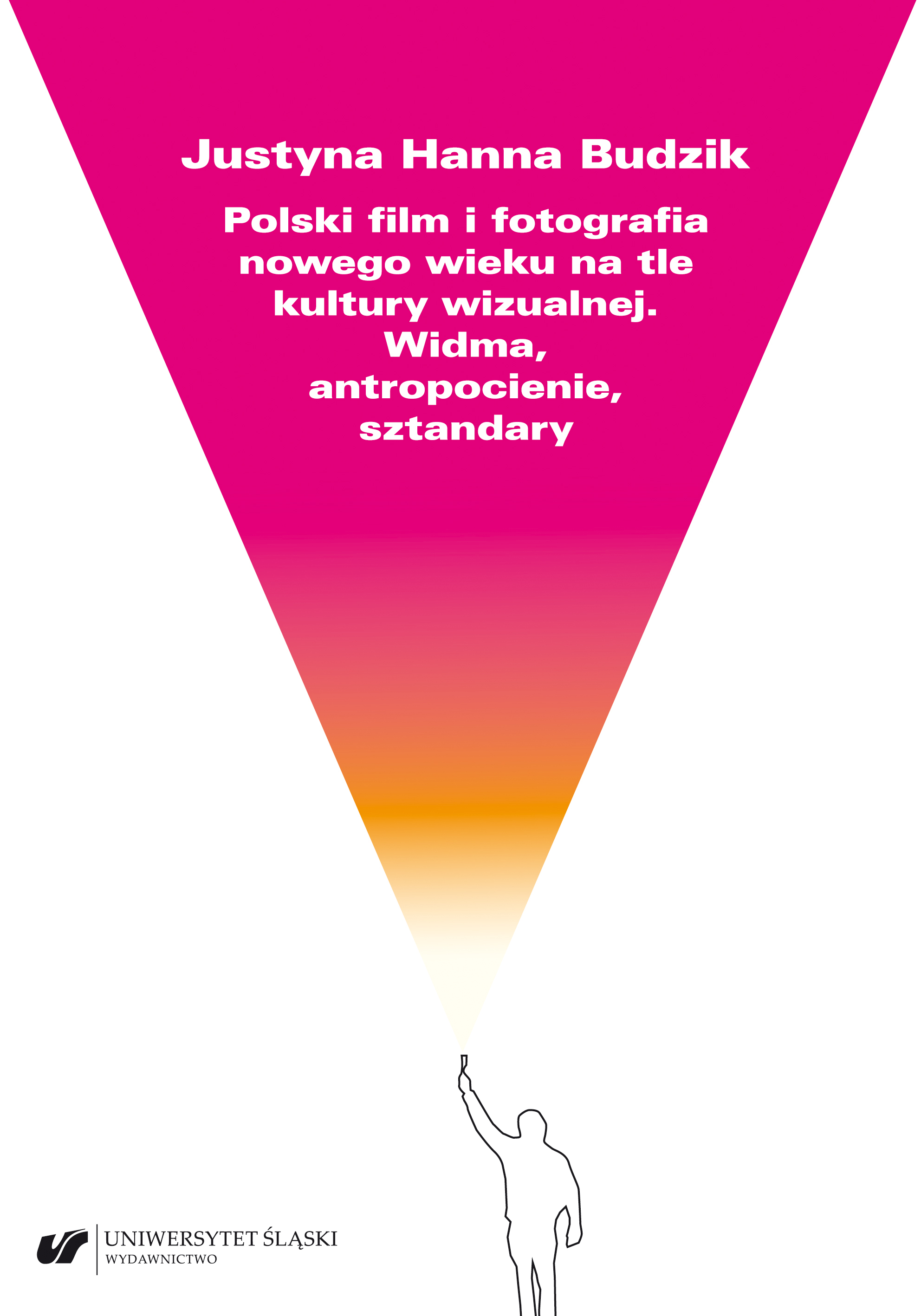
Keywords: film; photography; new humanities; vidmontology; visual culture
The book covers the findings of research on the 21st century Polish film and photography. For the purposes of this study, the terms film and photography are broadly understood and rooted in the culture studies perspective. Due to such framing, the author combines studies on fiction, documentary, short and feature-length films as well as documentary and staged photographs. The presented readings are created around three main categories of images, which are: spectres, shadows of the anthropos and banners.
More...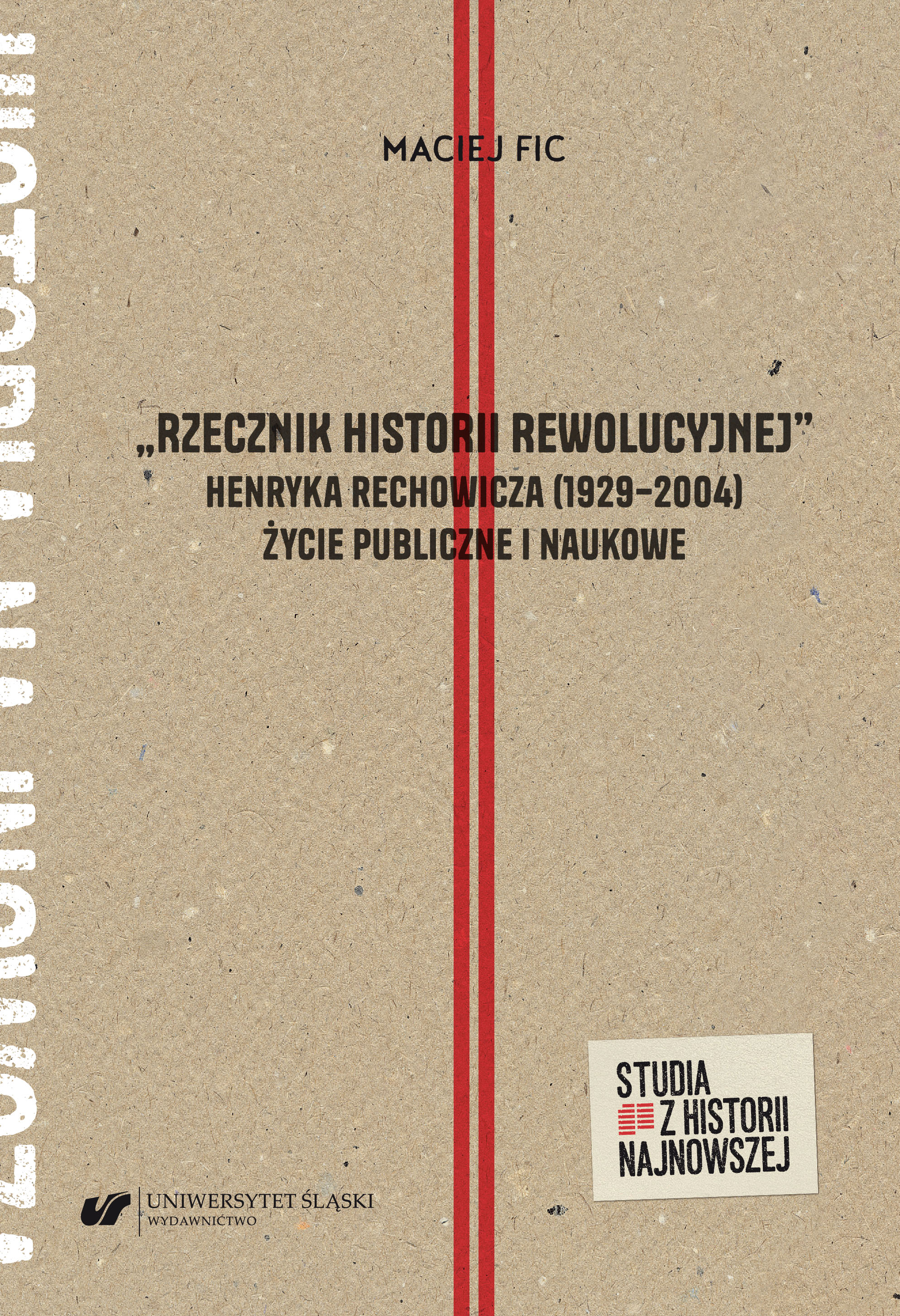
Keywords: Henryk Rechowicz; People’s Republic of Poland; Third Polish Republic; historical policy; Katowice; Silesian Voivodship; academic research
The book is one of the links of research on the development of historical research during the period of Polish “people’s Republic” and the careers of representatives of the scientific community and it is a kind of case study of the operation of the “court science" community of supporters and promoters. The course of the career of Henryk Rechowicz, a historian and activist of the PZPR born in Dąbrowa Basin, has been recreated: a brilliant promotion was highlighted first (inclusion of exposed positions in the scientific community of the Katowice Voivodeship), then degradation resulting from his belonging to a group centered around the “Gierek team", and then the return to scientific and academic work, made in reality by the end of the Polish People's Republic and the beginning of the Third Polish Republic.
More...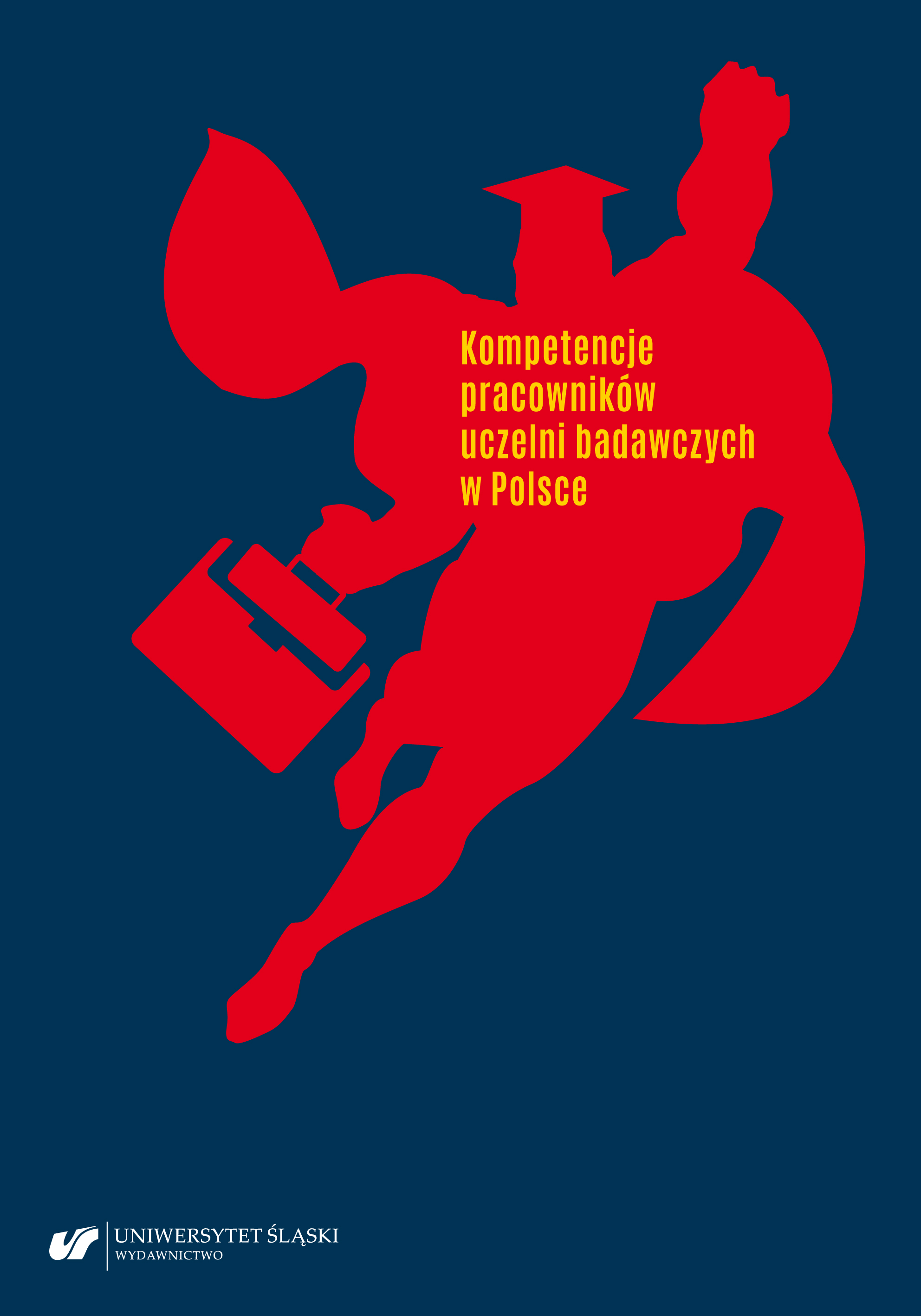
Keywords: competences; research worker; supporting staff; university
The book discusses the competencies required for effective research and support staff together with an assessment of their level of development. In Europe and worldwide, there is a slow but systematic increase in the number of universities appreciating the issue of managing the potential of university staff using the concept of competences, but it is still a rather novel approach for many universities. The research results presented in this publication confirm the complexity of the issues discussed. This is particularly true in the search for the relationship between competences and performance at the level of individual employees, research teams (together with their supporting staff) as well as entire universities. It is worth starting by stating that social competences constitute a significant component in the set of professional competences – both of research and support staff. It is possible to observe a rather pronounced variation in assessments, as well as the occurrence of a gap between expectations and assessment (i.e. the so-called 'competence gap'). Equally important are the findings concerning not only the level of expectations and assessments of individual competences, but also their relationship to performance. It turns out, for example, that in the case of the assistant position, competences such as analytical thinking, conscientiousness and cooperation were the most important in achieving high efficiency, whereas in the case of adiunkt, above-average competences in terms of striving for results and organising one's own work were crucial. In our view, this confirms the thesis that the development of academic staff is a multi-faceted process in which different competences play a key role at different stages of the process. It is not enough to be solely 'strong in content' to be successful. This is an important message especially for those who are just starting their scientific career. Finally, it is worth emphasising that the competences of staff groups (research staff and support staff) cannot be developed separately, but always in close combination with each other. It is not enough to have excellent researchers to build a scientifically strong university. It is equally important to strengthen the potential of support teams and in this respect – as it seems – Polish universities have a lot to do.
More...